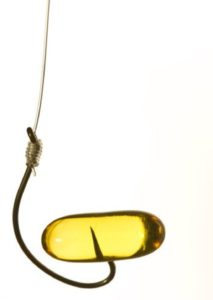Still on board with your New Year intentions toward healthier living? Great. In the spirit of helping you along, I will periodically introduce you to “new rules” that can make significant improvements to your well-being; yet be relatively effortless.
Let’s take a peeksie into your medicine cabinet.
How many bottles of vitamins and supplements do you see? So many of us impulsively purchase vitamins while temporarily impaired by ambitious designs that a healthier body is possible if we just take what is inside these promising, tempting little bottles. It’s a noble gesture. What you might not know is which of these you actually need, and which are redundant – or which are potentially dangerous. Some take the “pile it on” approach: if it’s there, take it. If the bottle suggests one pill, take two or three. These people consume a veritable cocktail of colorful gems enlisted to heal from the inside out. Others prefer a more streamlined attitude: grab the most comprehensive-looking bottle of multi-vitamins, and “down the hatch” it goes. One and done. Guess what? Neither are optimal, and both could prove costly in more ways than one.
So what should we be taking as far as supplements go?
Vitamin D3: Alright, now I know I’ve heard this a million times, “But I live in Colorado. We get plenty of sunshine“. It’s not enough. Especially in winter months, it is nearly impossible to get the appropriate exposure to sunlight necessary for Vitamin D production. And of course, I personally recommend limiting extraneous sun exposure due to the higher risks for skin cancer (go spf yourself, got it?). Lisa W. Corbin MD FACP, Medical Director at The Center For Integrative Medicine, University of Colorado Hospital estimates that in her practice that only about 1 in 50 people have sufficient levels of Vitamin D in their body. The rest of us are grossly deficient. Supplementation is a must.
Fish Oils: “If you pick one supplement to take, pick this one”, states Dr. Corbin. What we’re looking for here are Omega-3 fatty acids, found in cold water fish, walnuts, flaxseeds, and oils. Known for their anti-inflammatory benefits, these fatty acids also hold the key to improved heart health, are used in the treatment for depression, and may ward off mental decline as we age. Unless you are consuming at least three servings of fatty fish per week, you may want to seriously consider adding this supplement to your daily regimen. Dr. Corbin suggests staying away from cod liver oil, as it contains excessive Vitamin A.
Calcium with Magnesium: Calcium, as we all know, is essential to bone strength. Did you know, though, that for our body to absorb calcium it needs magnesium? Magnesium is a crucial component to our body- it is responsible for more than 300 biochemical reactions, including bone health. Combining calcium with magnesium not only supports bone health, but muscle health as well.
What? No multi-vitamin? Nope. As simple as it may seem to pop one pill for all of your needs, most people wind up ingesting too much or too little of certain vitamins and minerals when relying on a single pill. Redundant levels of anything could prove dangerous to your system. As innocuous as vitamins may appear, you can overdose just as easily as you can prescription pharmaceuticals.
But I have a whole bottle and they were expensive. Really, I hear this one a lot. If it makes you feel better, finish what you have and don’t buy another. Honestly though, what difference does it make if the pills are in your system or in the trash?
Which brings me to another point: do not flush pills down the toilet. Contaminated water supplies are a huge problem for this country and we are all unknowingly ingesting all sorts of prescription drugs from anti-depressants to hormone replacements. Don’t be that guy. There are several programs in place to safely dispose of old, unused supplements and medications. Check with your local pharmacy to find out more. Most of the time, you can drop them off there. Buy only what you think you will use; bulk vitamins will expire and you may be left with a collection of useless drugs.
One more critical point: remember, there are no government regulations in place regarding the manufacturing of supplements. Which means you could be taking a really expensive sugar pill. Consumer Lab Reports is a great resource for non-profit research and analysis of different brands and distributors. They independently test every year to ensure accurate labeling and consumer safety. There is a fee to view their findings, but might be a consideration if you are concerned. Dr. Lisa Corbin recommends checking for a “USP” label on the bottle, which means what is inside has been verified by the United States Pharmacopeia as containing the ingredients listed, does not have harmful contaminants, and can be used by the body.
What you put inside is just as important as how you treat your outside. Make intelligent, thoughtful choices about supplementation and you just might see the benefits you keep reading about. One size does not fit all.








